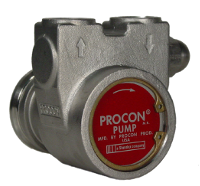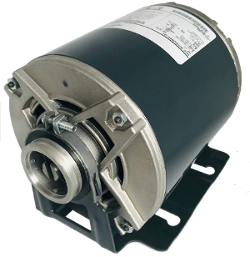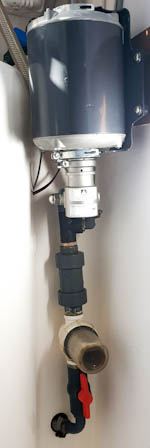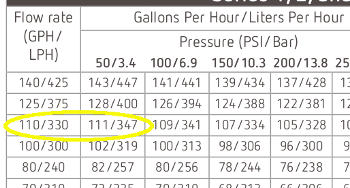Both Spectra and Schenker use an ordinary Shurflo pump. This is just a similar pump used for pressurizing the drinking water system, but has been "boosted" by a higher "cam" ratio and the addition of some cooling fins on its motor. It was originally never designed to run for hours at a time at an elevated pressure, so it is not surprising that these pumps wear out pretty quickly. After a while (your milage might vary) the flow starts to drop, which causes the membrane to foul, resulting in the pressure going up while the water production goes down. A high pressure and low production might indicate that the membrane has fouled; a lack of flow is the main suspect. The higher pressure might give the ignorant user the impression that the pump is working fine, but in reality the higher pressure causes the cam diaphragm to wear even faster, resulting in an even lower flow. A better (and earlier) indication that this downward spiral has started is by observing the sea water flow, which is why we recommend installing a flow gauge! We measured the brine flow to be about 270 L/h when the pump head is new, but it quickly drops to 240 L/h, and once it drops below 200 L/h it is really due for an overhaul. With our Schenker the amount of production water is about 10% of the total flow.
To be honest: After our pump modification we discovered that the main pistons were somewhat binding in the cylinders. This additional resistance might have acccelerated our Shurflo pump wear. We asked other cruisers with Schenkers how long their Shurflo pumps last, most of them reported longer life than in our situation.
Shurflo overhaul
Apart from buying the pump from your brand distributor, it is much cheaper to buy the pump from a Shurflo dealer. Watermaker manufacturers appear to try to keep the part numbers and their suppliers a secret, but after some research we found them anyway. These are the Shurflo part numbers (which are for our purpose all the same):
- 8000-943-838 Original pump
- 8008-943-839 Alternative
- 8000-543-238 Alternative
In most cases however, you don't have to replace the entire pump, not even the entire pump head. Usually, only the "cam diaphragm" in the pump head needs to be replaced to get the flow up to specs again. Both Spectra and Schenker use the cam diaphragm with 3.0 ratio wich is sold by Shurflo with the following part number:
- 94-385-32
Unfortunately, this cam diaphragm is "strategically prized" and is quite expensive compared to the pump as a whole. With about 80 USD it is still a considerate saving compared to replacing the entire pump though. If you are sailing in the Caribbean, the shop "Electec" on Sint Maarten has these cam diaphragms on stock.
Apart from wearing out pretty fast, our impression was that the pump, even in good condition, was always marginal at best. The promised 30 L/h was never reached, because various factors were negatively influencing the water flow:
- We installed the pump above the water line, for safety and maintenance reasons. This causes a negative pressure on the pump inlet, so it has to work harder, and the negative pressure often caused some air bubbles to appear (cavitation and micro leaks).
- Despite using very thick cables, we still lost some voltage from the batteries to the pump, and just half a Volt makes quite a difference for these Shurflo pumps. Our "technical wet room" was unfortunately quite a distance from our power house (batteries and solar chargers) so there was no easy solution possible.
- Despite cleaning the filters often, on average the filters were more restricting than brand new filters. We just can't use new filters every day...
It was quite annoying to have to replace the cam diaphragm twice a year, and never reaching a satistying water production for a long time. Beside this maintenance, the pump was very noisy. Because of its design, it was vibrating on all axis and it proved to be impossible to prevent the vibrations to broadcast an audible hum through the entire ship. Even the hoses were vibrating due to the pulsing nature of the pump output. It didn't take long before we really started to hate this Shurflo pump.
At some point, rumour reached us that Spectra had started to use a different kind of pump on its newer high capacity watermaker models. It took a bit of research to find out more about it: The brand of these pumps is Procon.

Procon pumps
Procon pumps are high quality rotary vane pumps, available in a myriad of configurations: three different housing materials, three different housing sizes, with or without overpressure valve, with a direct drive or magnetic drive, in any flow and pressure configuration, and a dozen different motors to drive the pump.
The choice of material was easy: only stainless steel is suitable for seawater. For pressure I aimed at about 8 bars, with the overpressure valve set at 12 bars, but the flow was a bit of a puzzle; Schenker doesn't specify this in their documentation. Since the best total flow I could get with the original pump was about 300L/h, with still less production than should be possible, I wanted somewhat more. The next step up was 330L/h. I selected silicium carbide vanes for extra duration. The magnetic drive was more expensive, failure prone, and the advantage wasn't completely clear: we understood that it prevents leakage into the motor in case of a seal failure, but if the pump motor is mounted "upside down" you won't have this problem anyway.

AC motor
Because of the inevitable voltage loss associated with long cable runs on 12V, I wanted the new motor to run on AC power. We have a powerful but efficient inverter and the loss should be less than by driving the pump directly from our 12V DC net.
It was calculated that a 1/3 HP motor should be sufficient to drive the pump, so that is what I ordered, but for some reason when I received the package (several months late due to Covid19) there was a 1/2HP motor in it. (After consulting with the supplier I was offered a replacement 1/3 HP motor free of charge!) The motor is what is called an induction (asynchronous) type: brushless and the RPM is coupled to the AC frequency, resulting in 1450 RPM on 50 Hz, 1725 RPM on 60 Hz.
A suitable motor, 115 and 230V, available at Amazon.
I earn a small commission if you buy it via this link, thanks for supporting me!
Variable frequency drive

The speed of the motor is determined by the AC frequency and practically independent of load and voltage. The pump and motor are dimensioned to operate just about right on our 50Hz inverter output, but I preferred to be able to control the speed by use of a so called variable frequency drive, with direct drive from the inverter output as a fall back option. The VFD also incorporates features like "slow start" and protection of the motor.
We selected a 400W (1/2 HP) version, with a single phase input, and a single phase output. Note that the latter is a rare option, but absoletely necessary to run a single phase motor.
This is the VFD I'm using, available at Amazon.
I earn a small commission if you buy it via this link, thanks for supporting me!
Testing the new setup
The first test was to run the pump directly from our inverter. When I switched the pump on for a few seconds, I thought that the pump was failing to prime, as I heard no other sound than a faint hum. To my surprise I saw a steady flow of water coming out of the brine hose! We couldn't believe how silent that pump is!
We measured the production water output and we saw 35 L/h coming out of our good old Schenker. This was more than it had ever done before! How about the water quality? The TDS with the previous pump was a little over 400 ppm, but with the new pump it was down to 234 ppm. This can be explained by the increased flow which flushes the salt residu much faster away than before, so the membrane sees a lower salinity at its input side.

- Additional input valve for easy access
- Strainer
- One way valve, to facilitate flushing with fresh water
- T-junction for injection of flush water
- Procon pump
- Motor
The only problem was that the current now had climbed to 30 Amps, three times more than before, and the pump motor was expelling a lot of heat, noticably heating up the small bathroom pretty fast. (This problem has now been solved, see below.) This was a bit odd, at least not expected. Anyway, it was time to try the Variable Frequency Drive (VFD). I had some trouble getting it going, but after consulting with the manufacturer and loading a different set of parameters in its configuration, it worked like a champ. To my surprise, at the same 50Hz as our inverter, the current was now down to about 20 Amps and the motor ran a lot cooler. Somehow the motor and our inverter are not a good match. A possible explanation is that the inverter is not built specifically to drive induction motors; it uses a lot of energy trying to make a nice "sinus", but the motor doesn't care too much about wave form and actually tries to distort it quite a bit with its very inductive load. The VFD is built to drive exactly this kind of motor so it can be much more efficient.
Because we could now regulate the flow independend of pressure it was easier to troubleshoot and we discovered that our main Schenker unit had a problem: the piston seals were dried out and causing a lot of resistance. After replacing the seals, polishing and lubricating the pistons and cylinder walls, the pressure dropped and the current immediately went down to 14 Amps! In hindsight, this undetected problem might have accelerated our Shurflo pump wear.
Anyway, the power consumption problem was solved. A current of 14A is for us acceptable: it is a bit higher than with the Shurflo pump, but the output of the watermaker is almost twice as high. Even then, we don't care if the current consumption is a tad higher: the absence of noise and the lower maintenance requirement make it a good deal. (Note: on 60 L/h models the current consumption wouldn't increase this much, see below).
Although we were happy with the 35L/h, the pressure on the watermaker was a bit high with 8 bars. After dialing a frequency of 45Hz, we got the pressure down to 7 bars while the production was still a little bit over 30L/h. With an even lower frequency, the pressure went down even more but so did also the production. 45Hz appeared to be the sweet point for our setup.
Intermediate conclusion
We are very happy with the Procon pump:
- It is extremely silent. The only thing we hear outside the bathroom is the "beat" of the pressure amplifier (Clark pump).
- The water production is higher than ever before.
- Water quality improved, TDS got significantly lower due to the improved flow.
- No more problems with voltage loss, drop of RPM when a cloud blocks the sun, etc.
- Very stable flow. The flow is strongly coupled to RPM (each rotation of the rotor delivers a fixed volume) and if the filter would foul, the RPM and thus flow would remain the same, but the pressure (and power consumption) would go up.
- We can adjust the flow with the VFD to maintain the ideal pressure for membrane and seawater temperature condition.
- It is too short to tell, but the Procon pump should last much longer than the Shurflo pump. There are no parts in the motor to wear out, other than the bearings. The vanes in the pump are coated with silicium carbide and should last quite a long time, and can be replaced when worn out.
In hindsight we should have selected a pump with a lower flow rate. Instead of "330 L/h" the 300 L/h option would have been a better match. We now run the pump at 45 Hz, which is 10% less than our inverter frequency. With the 300L/h pump we could run it at exactly 50 Hz to reach the same flow, which means that we could run it straight from the inverter. Still we like to have the VFD in between, so we can adjust the RPM and also benefit from the (not yet conclusively explained) higher efficiency.

Final conclusion (one year later)
We are still happy with the conversion. Some things we discovered:
- We had some wear on the pump, manifesting itself in a lower flow at pressure. This worsened over time. Thanks to the VFD we could just crank up the frequency to make up for the loss.
- In hindsight, we were lucky with our selected pump. We ran it at 45Hz initially but due to wear we had to crank up the frequency so we were actually happy that we didn't buy a model with a lower flow rate.
- Reason for the wear was our failure to install a better prefilter. The Shurflo pumps don't need much pre-filtering (they are actually quite sensitive to any "obstructions" on their inlets) but the vane pumps can experience accelerated wear due to abrasive particles in the water. After we overhauled the pump we started using a 50u pre-filter and we have not experienced any wear anymore.
Further thoughts, ideas and experiments
The only disadvantage of our current Procon setup is the power requirement, which is a bit higher than the Shurflo pump (disregarding the much higher water output). We could possibly save some power by:
- using a 1/3 Hp motor instead of the 1/2 Hp motor we received. (We tried it and it saved some power but not much).
- using a 3-phase motor instead of a single phase motor. 3-phase motors have a higher efficiency than single phase motors. But in this case you will sacrifice some redundancy because you can not run the motor anymore from just an inverter, you will absolutely need a VFD. Of course you can buy a spare VFD to regain this redundancy.
- upgrading to 60 L/h. When dissecting the Procon datasheets, we noticed that when a pump with a higher flow is selected, the required power doesn't go up with the same ratio. A pump with double the flow would only require 50% more power to drive it. To produce 60 L/h about 21 Amps would be required, which would be comparable to the original Shurflo setup. But to upgrade to 60 L/h we would have to install an additional membrane (like on the Schenker 50 model) or to replace it by a single larger membrane. Each 21" membrane can do about 30 L/h, a 40" membrane would be good for 60 L/h. Interestingly, 40" membranes are only 10% more expensive than the 21" membrane our Schenker is using and you will need only one.
Ordering and configuration notes
As an European, I have a 50 Hz inverter. If you want to run the system at 60 Hz, you need a pump with a lower flow to make up for the higher RPM. Or you use a VFD and just select 50 Hz or whatever frequency gives you the right flow.
Replacing the Shurflo pump of a 30L/h model
Procon pump: The model number of mine is 1W3110A11BA928, but this is for the 330 L/h model. The 300 L/h model (1W3100A11BA928) would actually be a better match if you want to run it straight from a 50 Hz inverter. This pump is stainless steel, has silicium carbide vanes for extra durability, direct drive, and the safety valve set at 175 PSI. I ordered this pump from pacificool.co.nz, they were very helpful.
Where to order a Procon pump
Initially it appeared nearly impossible to order a pump. Because of our Dutch origin, we were forwarded to the EU distributor (Standex) in Ireland. After multiple emails we were finally sent a lenghty questionaire and after returning it we didn't hear anything anymore. We also contacted the NZ dealer pacificool.co.nz and after explaining that we were sailing in the South Pacific they were entitled to accept our order. Pacificool was extremely helpful, answering promptly, forwarding technical questions to the manufacturers, supplying datasheets, but also very helpful in getting the pump as soon as possible to Tahiti for us to pickup.
AC Motor: 1/3 HP would be sufficient. I got mine from pacificool.co.nz together with the pump. There are several motors available, you need one with frame 48YZ (or frame 56C with adapter), I would suggest to get advice from the vendor. I have a Nidec 928, which can run on 115V and 230V, single phase. This motor has a startup winding which will automatically disconnect by a centrifugal switch when the RPM passes about 1150 rpm, which equals 40 Hz. I found this a bit too close to my favorite operating frequency of 45 Hz, so I stretched the springs a little to let it open at a lower RPM. It can now go down to 30 Hz without the centrifugal switch closing to the startup setting. You probably don't need to do this if you order the 300 L/h pump which requires 50 Hz.
There are several manufacturers producing these motors. This one on Amazon has exactly the same specifications:
A suitable motor, 115 and 230V, available at Amazon.
I earn a small commission if you buy it via this link, thanks for supporting me!
Variable Frequency Drive: This is optional. With a VFD you can adjust the RPM, you will have soft start, and efficiency might be better. We have model GK3000-1S0004. There is some info in the manual about modifications required on a single phase motor to make it run, but you can ignore that. Just connect the motor over the V and W terminals.
This is the VFD I'm using, available at Amazon.
I earn a small commission if you buy it via this link, thanks for supporting me!
The VFD has quite an extensive menu, the following options are changed from the defaults (you might need to change a few things if you run from 115AC instead of 230AC, or use a different motor): P0.06=60, P0.07=60, P0.08=240, P0.09=4, P0.12=6, P0.17=2, P0.18=1, P0.19=60, P0.20=45, P0.22=2.
Replacing the Shurflo pump of a 60L/h model
I haven't done this, but since this model uses two Shurflo pumps, it is a good guess you will just need to double the flow to 600 L/h. A Procon pump model 3 at 70Hz could deliver this, but a model 5 pump can do this at 50 Hz. You will need a 1/2 HP motor. Consult the datasheets or ask Procon for advice.
Upgrading a 30L/h model to 60L/h
This will double your production for only 50% more power consumption. You will have to either add another 21" membrane, or replace it by a single 40" membrane. The latter has the advantage that in the future it is much cheaper to replace the single 40" membrane than to replace two 21" membranes. In either case, you will have to replace some high pressure hoses to make everything fit. For the pump and motor I refer to the previous paragraph.
Lots of effort goes into the free information pages and services of this website. If you want to show your appreciation and support my efforts, you are welcome to contribute with a donation to my personal Paypal account.